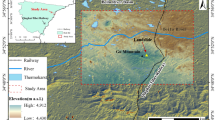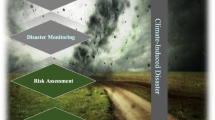Abstract
Accurate identification of Mesoscale convective systems (MCSs) is important for disaster prevention and management. Traditional MCSs identification methods are based on temperature and area thresholds. These methods are highly accurate for MCSs identification, but consume large computational resources. Deep learning models have made significant progress in the field of object identification. However, existing deep learning models do not take into account the characteristics of excessive differences in MCSs area coverage and uneven spatial distribution. Direct application of these models to this task may lead to the problems of missed identification of small MCSs and ambiguous identification of MCSS boundaries. In this paper, we construct a MCSs recognition dataset and propose a Multiscale Feature Enhancement Network (MFE-Net) for identifying MCSs. This model consists of two main modules: Feature Alignment Distribution Module (FADM) and Asymmetric Feature Recovery Module (AFRM). The FADM, which is used to aggregate multiscale information during the downsampling phase, aims to improve the perception of small-scale MCSs and prevent them from being lost during the downsampling process of the model. AFRM is designed to extract and preserve spatial edge features of MCSs from different spatial dimensions and accurately identify the edges of MCSs. The experimental results show that our MFE-Net achieves excellent performance both quantitatively and qualitatively.








Similar content being viewed by others
Explore related subjects
Discover the latest articles and news from researchers in related subjects, suggested using machine learning.References
Schumacher RS, Rasmussen KL (2020) The formation, character and changing nature of mesoscale convective systems. Nat Rev Earth Environ 1(6):300–314
Huang X, Hu C, Huang X, Chu Y, Tseng Y-H, Zhang GJ, Lin Y (2018) A long-term tropical mesoscale convective systems dataset based on a novel objective automatic tracking algorithm. Clim Dyn 51:3145–3159
Rajagopal M, Russell J, Skok G, Zipser E (2023) Tracking mesoscale convective systems in imerg and regional variability of their properties in the tropics. J Geophys Res Atmos 128(24):2023–038563
Feng Z, Leung LR, Liu N, Wang J, Houze RA Jr, Li J, Hardin JC, Chen D, Guo J (2021) A global high-resolution mesoscale convective system database using satellite-derived cloud tops, surface precipitation, and tracking. J Geophys Res Atmos 126(8):2020–034202
Na Y, Fu Q, Leung LR, Kodama C, Lu R (2022) Mesoscale convective systems simulated by a high-resolution global nonhydrostatic model over the united states and china. J Geophys Res Atmos 127(7):2021–035916
Ramos-Pérez O, Adams DK, Ochoa-Moya CA, Quintanar AI (2022) A climatology of mesoscale convective systems in Northwest Mexico during the North American monsoon. Atmosphere 13(5):665
Dixon M, Wiener G (1993) Titan: Thunderstorm identification, tracking, analysis, and nowcasting-a radar-based methodology. J Atmos Oceanic Technol 10(6):785–797
Johnson J, MacKeen PL, Witt A, Mitchell EDW, Stumpf GJ, Eilts MD, Thomas KW (1998) The storm cell identification and tracking algorithm: an enhanced wsr-88d algorithm. Weather Forecast 13(2):263–276
Haberlie AM, Ashley WS (2019) A radar-based climatology of mesoscale convective systems in the united states. J Clim 32(5):1591–1606
Wang J, Houze RA Jr, Fan J, Brodzik SR, Feng Z, Hardin JC (2019) The detection of mesoscale convective systems by the gpm ku-band spaceborne radar. J Meteorol Soc Japan Ser. II 97(6):1059–1073
Rasmussen KL, Zuluaga MD, Houze RA Jr (2014) Severe convection and lightning in subtropical South America. Geophys Res Lett 41(20):7359–7366
Houze RA Jr (2018) 100 years of research on mesoscale convective systems. Meteorol Monogr 59:17–21
Hu J, Shen L, Sun G (2018) Squeeze-and-excitation networks. In: Proceedings of the IEEE Conference on Computer Vision and Pattern Recognition, pp 7132–7141
Kampffmeyer M, Salberg A-B, Jenssen R (2016) Semantic segmentation of small objects and modeling of uncertainty in urban remote sensing images using deep convolutional neural networks. In: Proceedings of the IEEE Conference on Computer Vision and Pattern Recognition Workshops, pp 1–9
Hamaguchi R, Fujita A, Nemoto K, Imaizumi T, Hikosaka S (2018) Effective use of dilated convolutions for segmenting small object instances in remote sensing imagery. In: 2018 IEEE Winter Conference on Applications of Computer Vision (WACV), pp 1442–1450. IEEE
Maggiori E, Tarabalka Y, Charpiat G, Alliez P (2017) High-resolution aerial image labeling with convolutional neural networks. IEEE Trans Geosci Remote Sens 55(12):7092–7103
Long J, Shelhamer E, Darrell T (2015) Fully convolutional networks for semantic segmentation. In: Proceedings of the IEEE Conference on Computer Vision and Pattern Recognition, pp 3431–3440
Wang J, Zhong Y, Zheng Z, Ma A, Zhang L (2020) Rsnet: The search for remote sensing deep neural networks in recognition tasks. IEEE Trans Geosci Remote Sens 59(3):2520–2534
Ronneberger O, Fischer P, Brox T (2015) U-net: convolutional networks for biomedical image segmentation. In: International Conference on Medical Image Computing and Computer-assisted Intervention, pp 234–241. Springer
Shi C, Zhou Y, Qiu B (2021) Cloudu-netv2: A cloud segmentation method for ground-based cloud images based on deep learning. Neural Process Lett 53(4):2715–2728
Zhang L, Wei W, Qiu B, Luo A, Zhang M, Li X (2022) A novel ground-based cloud image segmentation method based on a multibranch asymmetric convolution module and attention mechanism. Remote Sens 14(16):3970
Lin T-Y, Goyal P, Girshick R, He K, Dollár P (2017) Focal loss for dense object detection. In: Proceedings of the IEEE International Conference on Computer Vision, pp 2980–2988
Lin G, Jones CR, Leung LR, Feng Z, Ovchinnikov M (2022) Mesoscale convective systems in a superparameterized e3sm simulation at high resolution. J Adv Model Earth Syst 14(1):2021–002660
Li Y, Shi X, Deng G, Li X, Sun F, Zhang Y, Qin D (2024) Dugs-unet: A novel deep semantic segmentation approach to convection detection based on fy-4a geostationary meteorological satellite. Atmosphere 15(3):243
Hodges K, Chappell D, Robinson G, Yang G (2000) An improved algorithm for generating global window brightness temperatures from multiple satellite infrared imagery. J Atmos Oceanic Technol 17(10):1296–1312
Rossow WB, Schiffer RA (1999) Advances in understanding clouds from isccp. Bull Am Meteorol Soc 80(11):2261–2288
Ocasio KMN, Evans JL, Young GS (2020) Tracking mesoscale convective systems that are potential candidates for tropical cyclogenesis. Monthly Weather Rev 148(2):655–669
Dong W, Lin Y, Zhang M, Huang X (2020) Footprint of tropical mesoscale convective system variability on stratospheric water vapor. Geophys Res Lett 47(5):2019–086320
Sun K, Xiao B, Liu D, Wang J (2019) Deep high-resolution representation learning for human pose estimation. In: Proceedings of the IEEE/CVF Conference on Computer Vision and Pattern Recognition, pp 5693–5703
He K, Zhang X, Ren S, Sun J (2015) Delving deep into rectifiers: surpassing human-level performance on imagenet classification. In: Proceedings of the IEEE International Conference on Computer Vision, pp 1026–1034
Wei J, Wang S, Huang Q (2020) \(\text{ F}^3\)net: fusion, feedback and focus for salient object detection. Proceedings of the AAAI Conference on Artificial Intelligence 34:12321–12328
Zhou Z, Rahman Siddiquee MM, Tajbakhsh N, Liang J (2018) Unet++: A nested u-net architecture for medical image segmentation. In: Deep Learning in Medical Image Analysis and Multimodal Learning for Clinical Decision Support, pp. 3–11. Springer
Azad R, Asadi-Aghbolaghi M, Fathy M, Escalera S (2020) Attention deeplabv3+: Multi-level context attention mechanism for skin lesion segmentation. In: European Conference on Computer Vision, pp 251–266. Springer
Zhuang J, Yang J, Gu L, Dvornek N (2019) Shelfnet for fast semantic segmentation. In: Proceedings of the IEEE/CVF International Conference on Computer Vision Workshops
Yu C, Gao C, Wang J, Yu G, Shen C, Sang N (2021) Bisenet v2: Bilateral network with guided aggregation for real-time semantic segmentation. Int J Comput Vis 129:3051–3068
Ning Z, Wang K, Zhong S, Feng Q, Zhang Y (2020) Cf2-net: Coarse-to-fine fusion convolutional network for breast ultrasound image segmentation. arXiv preprint arXiv:2003.10144
Lu M, Chen Z, Liu C, Ma S, Cai L, Qin H (2022) Mfnet: Multi-feature fusion network for real-time semantic segmentation in road scenes. IEEE Trans Intell Transp Syst 23(11):20991–21003
Ruan J, Xiang S, Xie M, Liu T, Fu Y (2022) Malunet: A multi-attention and light-weight unet for skin lesion segmentation. In: 2022 IEEE International Conference on Bioinformatics and Biomedicine (BIBM), pp 1150–1156. IEEE
Fei X, Li X, Shi C, Ren H, Mumtaz I, Guo J, Wu Y, Lv J, Wu X et al (2023) Dual-feature fusion attention network for small object segmentation. Comput Biol Med 160:106985
Xu J, Xiong Z, Bhattacharyya SP (2023) Pidnet: A real-time semantic segmentation network inspired by pid controllers. In: Proceedings of the IEEE/CVF Conference on Computer Vision and Pattern Recognition, pp 19529–19539
Hu X, Wang S, Qin X, Dai H, Ren W, Luo D, Tai Y, Shao L (2023) High-resolution iterative feedback network for camouflaged object detection. Proceedings of the AAAI Conference on Artificial Intelligence 37:881–889
Jiang Q, Cheng J, Wu Z, Cong R, Timofte R (2024) High-precision dichotomous image segmentation with frequency and scale awareness. IEEE Trans Neural Netw Learn Syst
Cheng J, Wu Z, Wang S, Demonceaux C, Jiang Q (2023) Bidirectional collaborative mentoring network for marine organism detection and beyond. IEEE Trans Circuits Syst Video Technol 33(11):6595–6608
Acknowledgements
This work was supported by the Sichuan Science and Technology program (Grant No. 2024YFG0001), and the National Natural Science Foundation of China (Grant Nos. 42130608 and 42075142).
Author information
Authors and Affiliations
Corresponding author
Additional information
Publisher's Note
Springer Nature remains neutral with regard to jurisdictional claims in published maps and institutional affiliations.
Rights and permissions
Springer Nature or its licensor (e.g. a society or other partner) holds exclusive rights to this article under a publishing agreement with the author(s) or other rightsholder(s); author self-archiving of the accepted manuscript version of this article is solely governed by the terms of such publishing agreement and applicable law.
About this article
Cite this article
Li, P., Huang, Z., Li, Y. et al. Mfe-net: a multiscale feature enhanced network for mesoscale convective systems identification. J Supercomput 81, 589 (2025). https://doi.org/10.1007/s11227-025-07065-5
Accepted:
Published:
DOI: https://doi.org/10.1007/s11227-025-07065-5




